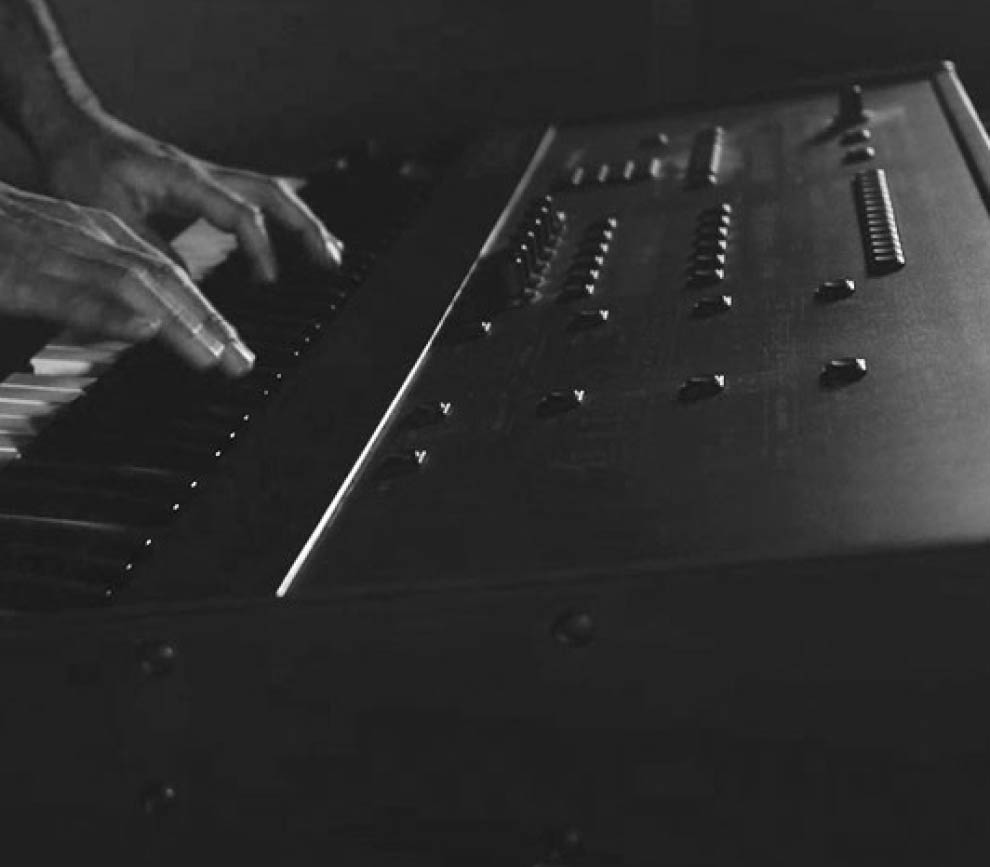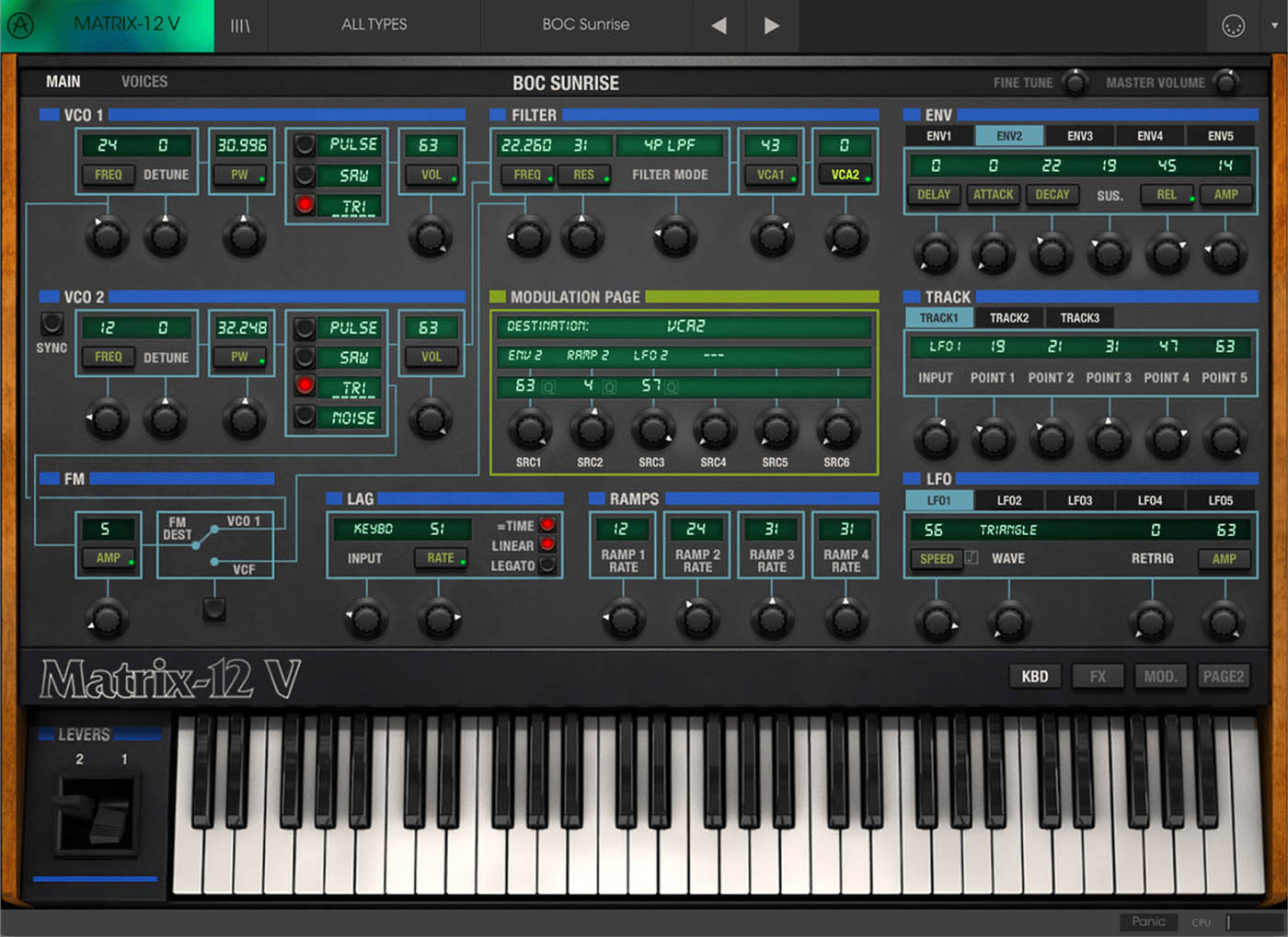Entrez dans
la Matrice
Extreme patching met 12 dual-oscillator voices in one of the most prestigious keyboard synths of the ’80s.
With 27 modulation sources, 47 destinations, 15 filter modes, and five envelopes, it combined the flexibility of a modular synth with the polyphony and programmability demanded by artists like Toto, Vangelis, Prince, and Herbie Hancock. How do you improve upon such an instrument? Matrix-12 V balances absolute authenticity with the flexibility modern music makers need - and then some.
You Can’t Sample This
Our True Analog Emulation® technology models the behavior of every circuit and how they interact. Matrix 12-V is one of its biggest achievements yet.
Your Everything Synth
Whether you make power-pop, electronica, R&B, hip-hop, or a fusion of styles yet to have a name, Matrix-12 V delivers head-turning sounds with remarkable ease.
An Ace in Your Hand
The Matrix could sound like virtually every other analog polysynth of the ’80s — and some digital synths — but no other synth could sound like the Matrix.
Own a Legend
A working Matrix-12 fetches five figures if you can find one. Matrix-12 V offers perfect accuracy at a tiny fraction of the cost, and with modern stability.
Analog in
a digital world
With digital synths like the DX7 and affordable sample-based keyboards just over the horizon, Tom Oberheim and company set out to show the world what a no-holds-barred analog machine could really do.
Echoing Oberheim’s earlier success with the SEM, the project began with a sound expansion module. This was 1984’s Xpander, which had six voices and the same signal path as the Matrix-12, which would arrive just a year later.
MIDI created a market for modules that could augment the capabilities that synth players already owned without adding the bulk of another black-and-white keyboard to their rigs. The Xpander was designed by engineers Marcus Ryle (who would later invent the Alesis® ADAT) and Michael Doidic, and became an instant hit.
Discover the history of Matrix-12
Agent
of analog
Matrix-12 V puts your hands on more of the original’s parameters at once.
It’s a playground for quick tweaks during live performance and exacting sound design in the studio.
Because it applied digital control to analog tone generation, the Matrix-12 had three displays and many pages of functions but only six knobs. We thought a sound engine this sensational deserved a lot more.

_1
_2
_3
_4
_5
_6
01. Original Oscillators
We began with faithful models of the oscillators, which feature pulse, saw, and triangle waves, PWM, hard sync, FM, and noise.
02. 15 Filters in One
That’s right — multiple pass modes, multiple slopes, and even phase-shifting filters let the Matrix create tones other analog synths can’t.
03. Pushing the Envelope
Why settle for just volume and filter envelopes when you can have five assignable ones? Create sounds that evolve in interesting and unexpected ways.
04. LFO Flexibility
Explore 5 tempo-syncable LFOs ready to apply to anything - and that’s just the tip of Matrix-12 V’s modulation iceberg.
05. Modulation Central
Press any parameter’s button to see all the sources that modulate it, and work with up to six sources at once.
06. Ramp It Up
Four ramp processors are like extra one-stage envelopes you can apply to any signal.
Matrix
Reloaded
More modulation, built-in FX, and a powerful Multi mode make you the architect of amazing sounds.
We dove deep into what makes the Matrix-12 special, put every parameter of it within easy reach, and then freed its analog mind with some reality-bending upgrades.

Tweak a superhero’s eye view of every modulation routing in Matrix-12 V at once. With up to 40, you’ll never run out of them.

Splits or layers? How about six independent keyboard zones with adjustable range, MIDI channel, and voice allocation?

Assign Matrix-12 V’s voices to keyboard zones and transpose, detune, and pan them here. Each voice can play a different patch if you want!

As if five LFOs weren’t enough, an independent vibrato lets you modulate its speed and amount from the mod wheel, a pedal, or aftertouch.

Choose from studio-grade classics including phaser, flanger, chorus, analog delay, stereo ping-pong delay, and lush reverb.

Achieve electron microscope level control over Matrix 12-V’s behavior with the settings located on Page 2.
Écoutez-le
en situation
Journey from the neon-lit streets of the 1980s to off-planet colonies and beyond with these audio demos from our community of artists and sound designers, made exclusively using Matrix-12 V sounds.
Escapes
In The Matrix
Selecting Presets
Trap
Rifts
A downtempo track with strong eerie feeling, taking advantage of the various filters modes, on board effects and voice parameters to fill the stereo width and audio spectrum.
Sunset
This minimalist demo features a light lead, the "Mountain Echo" preset, and a filter glide effect which take you to an other dimension.
Brian Molo
Artistscorner

Inclus dans
V collection
Les claviers de légende réinventés
Cet instrument fait aussi partie de la fameuse V Collection, qui regroupe de nombreux synthés de légende, d’orgues, de pianos et autres claviers qui ont fait l’histoire de la musique. Ils ont été modélisés avec les technologies les plus pointues pour un réalisme frappant, tout en bénéficiant de l’ajout de nouvelles options créatives. La V Collection met à votre disposition les meilleurs claviers de tous les temps, que ce soit en tant que plug-ins dans un DAW, ou en tant qu’instruments individuels autonomes sur scène.
Plus d’infos
Toutes les fonctionnalités
dont vous avez besoin

Les tutoriels intégrés détaillent chaque aspect de l’instrument, des différents paramètres aux conseils de nos designers sonores, pour que vous puissiez vous concentrer sur votre créativité. C’est simple comme bonjour !

L’Arturia Software Center vous sert à télécharger, organiser et mettre à jour tous vos logiciels d’Arturia au même endroit, ou encore à gérer toutes vos licences sur plusieurs appareils. Plus c’est simple, mieux c’est.

Nos instruments virtuels et nos plug-ins sont conçus pour s’intégrer facilement à votre installation. Quel que soit votre style, vous pouvez expérimenter tout en profitant d’une parfaite compatibilité avec les principaux DAW, aussi bien sur Windows que sur macOS.

Ne passez pas des heures à chercher le son que vous avez en tête. Le navigateur intelligent vous permet de trier les presets par mots-clés, par type d’instrument, style musical, etc. Vous pouvez même sauvegarder vos sons favoris pour les rappeler instantanément dès que vous en avez besoin.

Vous voulez profiter de nos émulations d’instruments classiques avec une immersion visuelle totale ? Vous préférez économiser un peu d’espace sur votre écran ? Les interfaces de tous les instruments virtuels d’Arturia peuvent être redimensionnées à la taille qui vous convient.

Les paramètres des instruments sont directement assignés aux commandes des claviers de la gamme KeyLab d’Arturia, mais ils fonctionnent aussi très bien avec d’autres contrôleurs MIDI. Vous bénéficiez ainsi de macros pour modifier instantanément le son, d’une intégration facile avec le DAW et d’un fonctionnement indépendant.
Le pouvoir de la TAE®
C’est la TAE®, notre technologie de modélisation analogique, qui permet de reproduire fidèlement les sonorités des instruments et des effets dont nous nous inspirons pour nos logiciels.
En reproduisant avec précision les caractéristiques des oscillateurs analogiques, des filtres et de l’écrêtage doux, nous conservons dans nos logiciels le charme du son propre aux machines analogiques, ainsi que leur caractère lié aux différents composants électroniques qui les constituent.
Plus d’infos
Galerie
Caractéristiques principales
Two oscillators, each offering triangle, sawtooth and variable-width pulse wave with PWM.
Oscillator 2 also functions as a white noise generator.
Oscillator 1 or the Filter can be frequency modulated.
Single filter with 15 modes: 4 Low Pass, 3 High Pass, 2 Band Pass modes, Notch and Phase Shift plus four additional "combo" filter modes.
Ultra-powerful modulation matrix with 27 sources and 47 destinations.
Sources include 5 envelopes, 5 LFOs, 4 Ramp, 3 Track generators, Velocity, Pressure, Keyboard follow, and more.
Two insert effect slots with six studio-grade effects available.
12 voices of polyphony like the original instrument
Multitimbral
Works in Standalone, VST, VST3, AU, AAX.
Exigences techniques
Windows
- Win 10+ (64bit)
- 4 GB RAM
- Processeur quadricœur, 3,4 GHz (4,0 GHz Turbo-boost)
- 3 Go d'espace libre sur le disque dur
- Processeur graphique compatible avec l’OpenGL 2.0
- Ne fonctionne pas avec les processeurs ARM sous Windows
Configuration requise
- Logiciel standalone, plug-in VST, AAX, Audio Unit et compatibilité avec le NKS (DAW en 64 bits uniquement)





Apple
- Mac OS 11+
- 4 GB RAM
- Processeur quadricœur, 3,4 GHz (4,0 GHz Turbo-boost) ou processeur M1
- 3 Go d'espace libre sur le disque dur
- Processeur graphique compatible avec l’OpenGL 2.0
Compatible avec l’ASC
- L’Arturia Software Center est un outil qui vous permet d’installer, d’activer et de mettre à jour facilement nos logiciels.
Tous les noms de fabricants et de produits mentionnés sur cette page sont des marques commerciales appartenant à leurs propriétaires respectifs, lesquels ne sont en aucun cas associés ni affiliés à Arturia. Les marques commerciales d’autres fabricants sont utilisées aux seules fins d’identification des produits de ces marques, dont les caractéristiques et le son ont été étudiés durant le développement. Tous les noms des équipements, inventeurs et fabricants ont été uniquement inclus à titre illustratif et éducatif, et ne suggèrent en aucun cas une affiliation ni une approbation de la part des inventeurs ni des fabricants des équipements.
Oberheim® is a registered trademark of Tom Oberheim®, which is in no way associated or affiliated with Arturia. All manufacturer and product names mentioned on this page are trademarks of their respective owners, which are in no way associated or affiliated with Arturia. The trademarks of other manufacturers are used solely to identify the products of those manufacturers whose features and sound were studied during the development. All names of equipment, inventors, and manufacturers have been included for illustrative and educational purposes only, and do not suggest any affiliation or endorsement by any equipment inventor or manufacturer.







